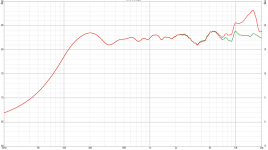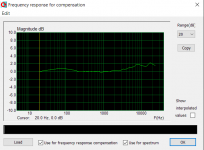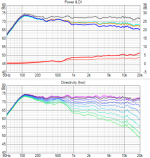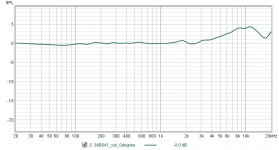I want to ask Sonarworks XREF20 users.
When I'm designing speakers for flat response with XREF20 then my speakers have harsh sound with too much treble. I have to correct crossover by lowering treble but then frequency response looks odd, with lowered treble area. Recently I've borrowed miniDSP UMIK-1 microphone with calibration file and repeated measurements. And suddenly everything was clear. Look at the attached picture. Green line is speaker designed with XREF20 for flat amplitude and red is the same speaker measured with UMIK-1. So calibration file for my XREF20 is incorrect. I've asked Sonarworks for explaining. Maybe it's possible they make mistake during uploading calibration file for my mic? We will see.
Sonarworks XREF20 users. Do you have good measurements results using this microphone?
When I'm designing speakers for flat response with XREF20 then my speakers have harsh sound with too much treble. I have to correct crossover by lowering treble but then frequency response looks odd, with lowered treble area. Recently I've borrowed miniDSP UMIK-1 microphone with calibration file and repeated measurements. And suddenly everything was clear. Look at the attached picture. Green line is speaker designed with XREF20 for flat amplitude and red is the same speaker measured with UMIK-1. So calibration file for my XREF20 is incorrect. I've asked Sonarworks for explaining. Maybe it's possible they make mistake during uploading calibration file for my mic? We will see.
Sonarworks XREF20 users. Do you have good measurements results using this microphone?
Attachments
I have been considering the XREF20 lately as it's available somewhat locally
This is concerning. I am curious to how your customer service experience concludes. Looking forward to following this. Shame it's happening to you though.
This is concerning. I am curious to how your customer service experience concludes. Looking forward to following this. Shame it's happening to you though.
The curves match pretty well except for treble.
You point mic to speaker or to the ceiling?
You use 90 or 0 degree calibration?
You point mic to speaker or to the ceiling?
You use 90 or 0 degree calibration?
Member
Joined 2003
What does you calibration file look like, can you post it? Or open it in REW or Vituix and post a screenshot of the plot?
Regardless, I would not expect a very harsh sound from a few dB lift at 16-17kHz, there's not much going on up there and many people can't hear past 15kHz anyway. Usually a harsh sound is a result of a low quality tweeter with too low of crossover, or woofer breakup not being suppressed (poor chosen crossover frequency and slopes). Overall tweeter level looks ok.
Regardless, I would not expect a very harsh sound from a few dB lift at 16-17kHz, there's not much going on up there and many people can't hear past 15kHz anyway. Usually a harsh sound is a result of a low quality tweeter with too low of crossover, or woofer breakup not being suppressed (poor chosen crossover frequency and slopes). Overall tweeter level looks ok.
Last edited:
Member
Joined 2003
I have been considering the XREF20 lately as it's available somewhat locally
This is concerning. I am curious to how your customer service experience concludes. Looking forward to following this. Shame it's happening to you though.
Hey Mortron,
For low cost option please have a look at my sale here for Dayton EMM-6, rather similar mic to the XREF.
Dayton EMM-6 Electret Measurement Microphone
For another option that needs no calibration file, I am now using a Line Audio OM1, I can send you the contact for the Canadian supplier, its a bit more pricey though at $210 + $15 shipping.
Sonarworks give you only one calibration file, for 0 deg.
Mic was pointed directly to speaker baffle with 1m distance.
For UMIK you have calibration files for 0 an 90 deg. And they are reliable because if you compare results with mic pointed directly, or angled 90 degrees results are almost identical.
Maybe I described sound incorrectly. It wasn't harsh, it was very bright with too much treble.
I'm still waiting for Sonarwork's support answer. They promised to reply within 72 hours on working days so they are late.
Mic was pointed directly to speaker baffle with 1m distance.
For UMIK you have calibration files for 0 an 90 deg. And they are reliable because if you compare results with mic pointed directly, or angled 90 degrees results are almost identical.
Maybe I described sound incorrectly. It wasn't harsh, it was very bright with too much treble.
I'm still waiting for Sonarwork's support answer. They promised to reply within 72 hours on working days so they are late.
I agree with decibel, the top octave boost does not look to bad, many speaker mfrs uses a similar response to achieve a power response or off axis responses that does not sound too dull, but for sure can be heard if you are young and maybe listening straight on axis and perhaps in the nearfield
Maybe top octave boost does not look to bad but I think calibration file should be accurate. Don't you?
Absolutely, but there seems to be quite commen that mic calibration files is not as accurate as they should be
Last edited:
Hmm that might explain why my speaker sounds bright at the upper treble, even though the treble > 10 kHz was slighty reduced, according to simulations based on measurements with this mic.
Attached: 0 deg calibration file of my XREF20, extrapolated to 24 kHz, and VituixCAD simulation. Ignore the off-axis hump at 600 Hz, I'm not sure what is happening there.
Attached: 0 deg calibration file of my XREF20, extrapolated to 24 kHz, and VituixCAD simulation. Ignore the off-axis hump at 600 Hz, I'm not sure what is happening there.
Attachments
Last edited:
Seems to me the calibration file isn't right. Did you reload it from the sonarworks site? And is the correction implemented in the measurement app correctly?
When the mike responds above reference level, the correction should be negative. And a good correction file contains data that corrects the mike to reference output given a reference SPL input.
It is a strange result though. These mikes often have higher sensitivity from 5kHz upwards. This one shows the opposite. Altering the correction file by hand is an option, given that the UMIK is rather reliable.
It is a strange result though. These mikes often have higher sensitivity from 5kHz upwards. This one shows the opposite. Altering the correction file by hand is an option, given that the UMIK is rather reliable.
Last edited:
How does cal files work in softwares,by adding the response or substract?
In REW the mic cal file values are subtracted. So the mic cal file posted by TBTL in post #10 shows a mic that is overly sensitive around 70 Hz and in the upper treble.
From the REW help file:
"It should contain the actual gain (and optionally phase) response of the meter or microphone at the frequencies given, these will then be subtracted from subsequent measurements"
from the website: "Each Sonarworks microphone is an individually calibrated professional measurement tool that ensures a flat frequency"
like other budget priced "calibrated" mics, no specification is given to how flat and over which range of frequencies.
like other budget priced "calibrated" mics, no specification is given to how flat and over which range of frequencies.
Budget mikes often do fine when in DIY. Since crossovers more often than not only work in the range 200Hz-5kHz, your average microphone has to be reasonably flat in that range. Most of the cheap mikes succeed in that. For top high I’d trust the datasheet of the tweeter.
Member
Joined 2003
Yes, if you take a measurement of a tweeter at short distance of like 12cm and the top end is far off from what you expect, then there is cause for concern.
When using ARTA, one thing to consider is that the mic calibration compensates for frequency amplitude only, the phase remains as measured, so if absolute phase accuracy is important to you, then best to use a mic that is relatively flat to begin with.
The calibration file shown by TBTL at least looks like a proper calibration file, so I would not rule the XREF out just yet as completely bogus calibration, however human error does exist so it's possible they have mixed up a couple serial numbers and have provided incorrect calibration data. Hard to say, but they haven't provided any guarantee of accuracy in the product literature, so it could be calibrated to be within +/- 10dB for all you know.
I recently purchased Line Audio OM1, very good mic for measurement IMO even though it doesn't include a calibration file, its remarkably flat on it's own without it. Cost is more than the XREF but reasonable all things considered.
When using ARTA, one thing to consider is that the mic calibration compensates for frequency amplitude only, the phase remains as measured, so if absolute phase accuracy is important to you, then best to use a mic that is relatively flat to begin with.
The calibration file shown by TBTL at least looks like a proper calibration file, so I would not rule the XREF out just yet as completely bogus calibration, however human error does exist so it's possible they have mixed up a couple serial numbers and have provided incorrect calibration data. Hard to say, but they haven't provided any guarantee of accuracy in the product literature, so it could be calibrated to be within +/- 10dB for all you know.
I recently purchased Line Audio OM1, very good mic for measurement IMO even though it doesn't include a calibration file, its remarkably flat on it's own without it. Cost is more than the XREF but reasonable all things considered.
Hmm that might explain why my speaker sounds bright at the upper treble, even though the treble > 10 kHz was slighty reduced, according to simulations based on measurements with this mic.
Attached: 0 deg calibration file of my XREF20, extrapolated to 24 kHz, and VituixCAD simulation. Ignore the off-axis hump at 600 Hz, I'm not sure what is happening there.
Hi TBTL, sorry to jump in here but looking at your VituixCAD response and in particular at de DI, I'm wondering what speaker it is ?
This is my XREF20 calibration file which is a bit different to TBTL's so it would seem that the claim for them to be individual is true. It works for me and I have compared measurements I took of a TC9 driver to many others posted and they all agree pretty well so I feel confident it is not too far out of cal.
I made my own 90 degree file following this method and it works well
How to make a 90 degree calibration file
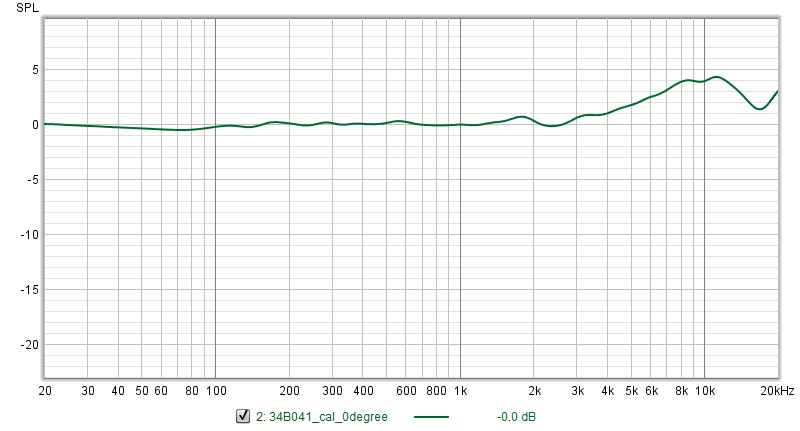
I made my own 90 degree file following this method and it works well
How to make a 90 degree calibration file
Attachments
It's a two way speaker with an 8" woofer in a closed box and a 1" metal dome tweeter. The tweeter is mounted in an 8" 100 deg axisymmetric waveguide and crossed over at 1200 Hz, with Linkwitz-Riley 4th order acoustic slopes.Hi TBTL, sorry to jump in here but looking at your VituixCAD response and in particular at de DI, I'm wondering what speaker it is ?
- Home
- Loudspeakers
- Multi-Way
- Sonarworks XREF20 unreliable calibration file
